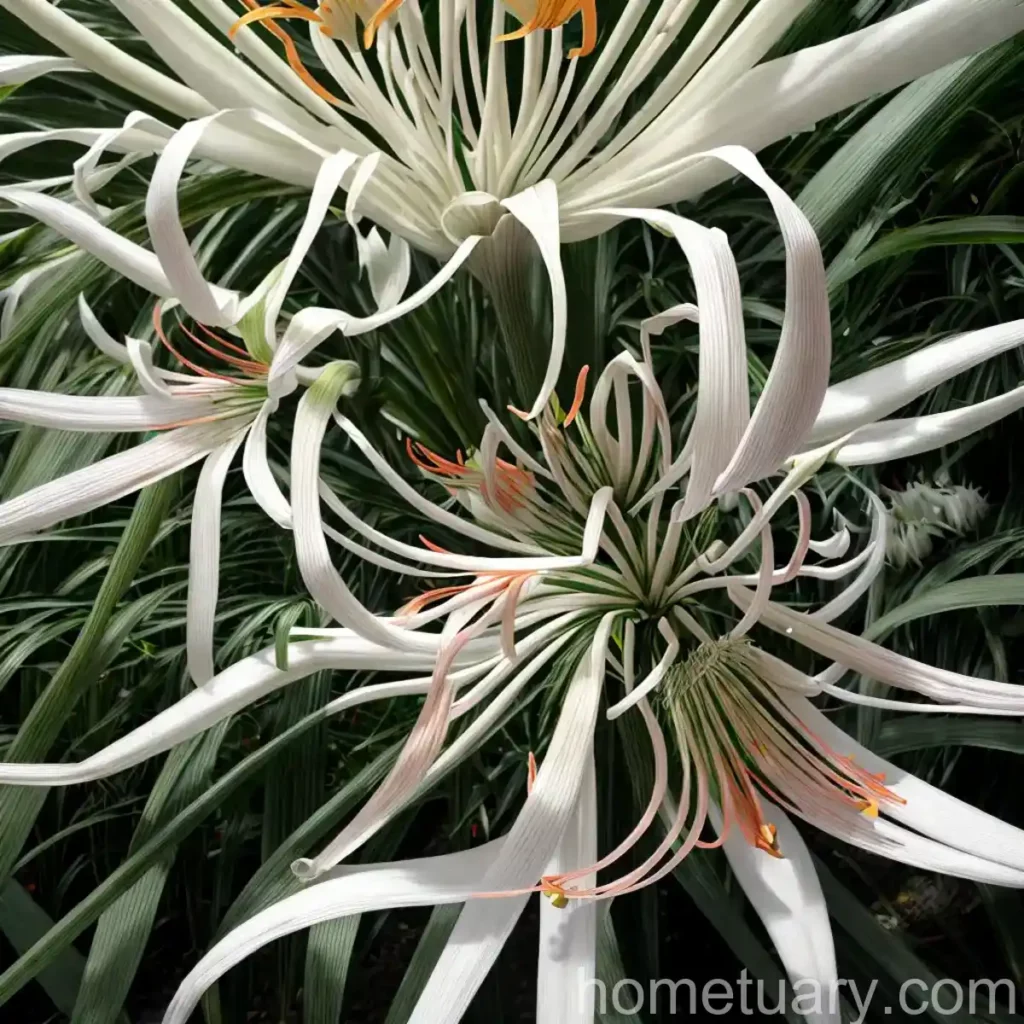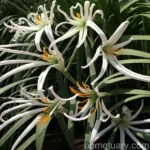Spider Lily (Hymenocallis x festalis ‘Zwanenburg’): Unveiling the Mystique of a Unique Flowering Plant
Plants are nature’s gift to humanity, offering an array of shapes, colors, and fragrances that captivate our senses and enrich our lives. Among the vast variety of plants gracing our planet, spider lilies hold a special intrigue. In this extensive guide to spider lilies, we will explore every facet of these enchanting plants, with a special focus on the Hymenocallis x festalis ‘Zwanenburg’ variety.
What is a Spider Lily (Hymenocallis x festalis ‘Zwanenburg’)?
The spider lily, scientifically known as Hymenocallis x festalis ‘Zwanenburg,’ is a stunning flowering plant belonging to the Amaryllidaceae family. It is characterized by its mesmerizing white, star-shaped blooms and possesses a captivating fragrance that complements its visual allure. The name “spider lily” is derived from the intricate and delicate appearance of its blossoms, which resemble the legs of a spider.
This plant is a hybrid, created by crossing Hymenocallis narcissiflora and Hymenocallis longipetala. It combines the best traits of its parent species, resulting in a unique and desirable ornamental plant that captivates gardeners and plant enthusiasts alike.
Key Takeaways – Spider Lily (Hymenocallis x festalis ‘Zwanenburg’)
Before delving into the specifics of cultivating and caring for the spider lily, let’s take a moment to summarize the key takeaways regarding this captivating plant:
- Common Name: Spider Lily
- Scientific Name: Hymenocallis x festalis ‘Zwanenburg’
- Family: Amaryllidaceae
- Distinct Features: Star-shaped white blooms with a captivating fragrance resembling the legs of a spider
- Cultural Significance: Regarded as a symbol of beauty and elegance, often used in floral arrangements for special occasions
With an overview of the spider lily’s essential characteristics, let’s proceed to explore the various facets of its cultivation and maintenance.
Culture of Spider Lily (Hymenocallis x festalis ‘Zwanenburg’)
Cultivating the spider lily encompasses a broad spectrum of practices, from understanding its water and sunlight requirements to nurturing its growth through proper soil and fertilizer applications. Let’s delve into the cultural practices essential for fostering the optimal growth and blooming of spider lilies.
Uses
The spider lily, beyond its ornamental appeal, serves various purposes, enriching both indoor and outdoor spaces with its exquisite beauty. Its primary uses include:
- Ornamental Planting: Adorning gardens, landscapes, and floral arrangements with its mesmerizing white blossoms
- Indoor Décor: Enhancing interior spaces with elegant cut flowers, lending a touch of natural charm to any setting
- Symbolic Significance: Incorporating spider lilies into cultural events, weddings, and celebrations as symbols of purity, beauty, and elegance
The multifaceted uses of spider lilies make them a prized addition to horticultural practices, elevating the aesthetics and ambiance of any environment.
Water
Ensuring proper watering practices is paramount for the healthy growth and blooming of spider lilies. These plants thrive in moderately moist soil conditions and require regular watering, especially during their active growth and blooming periods. Adequate drainage is essential to prevent waterlogging, which may lead to root rot and other undesirable conditions.
Sunlight
Spider lilies exhibit a preference for partial to full sunlight, making them ideal choices for well-lit garden beds and sunny borders. These plants flourish in bright, indirect light and require a minimum of 6-8 hours of sunlight daily to thrive and produce robust blooms.
Fertilizer
Nutrient-rich soil is essential for sustaining the vigor and blooming capacity of spider lilies. They respond favorably to balanced fertilizer applications, with an emphasis on phosphorus to promote robust flowering. Gradual-release fertilizers and organic amendments are recommended for sustaining the plant’s nutritional requirements throughout its growth cycle.
Soil
The soil conditions play a pivotal role in determining the overall health and vitality of spider lilies. These plants thrive in well-draining, loamy soil with a slightly acidic to neutral pH range. Amending the soil with organic matter and ensuring proper aeration are essential for creating an optimal growing medium for spider lilies.
Pruning
Pruning is a fundamental practice for maintaining the aesthetic appeal and health of spider lilies. Deadheading spent blossoms and trimming back overgrown foliage contribute to the plant’s rejuvenation and encourage the production of new flowers. Pruning also serves to prevent disease and pest infestations by removing damaged or diseased plant parts.
Propagation
The propagation of spider lilies can be accomplished through various methods, including division of bulbs, seed propagation, and offsets. Dividing mature bulbs in the fall and replanting them in favorable locations promotes the expansion of spider lily clusters and encourages prolific blooming. Seed propagation requires patience and careful nurturing to yield mature flowering plants.
Container Popularity
Spider lilies are well-suited for container gardening, lending a touch of elegance and natural beauty to patios, balconies, and indoor spaces. Their compact size and captivating blooms make them popular choices for container cultivation, allowing enthusiasts to enjoy their ornamental charm in confined spaces.
Container Common Diseases
Container-grown spider lilies are susceptible to certain diseases, including root rot, fungal infections, and pest infestations. Regular monitoring of the plant’s health, coupled with appropriate cultural practices, can mitigate the risk of diseases and ensure the optimal growth of spider lilies in containers.
Disease Diagnosis
Diagnosing and addressing diseases affecting spider lilies is crucial for preventing widespread damage and preserving the plant’s vitality. Common diseases such as botrytis, powdery mildew, and bulb rot require early detection and targeted treatments to safeguard the plant’s health and ensure its continued blooming.
Common Pests
Spider lilies may fall prey to various pests, including aphids, thrips, and spider mites, which can compromise the plant’s health and diminish its ornamental appeal. Vigilant pest monitoring and the timely application of organic pest control measures are pivotal for safeguarding the plant from pest infestations.
Botanist’s Tips for Spider Lily Care
Armed with the knowledge of the cultural practices essential for cultivating and nurturing spider lilies, let’s explore some expert tips and recommendations for ensuring the optimal care and maintenance of these enchanting plants:
- Regulated Watering: Monitor soil moisture carefully to prevent waterlogging and drought stress, ensuring consistent and moderate watering for the plant’s sustained growth and blooming.
- Sunlight Optimization: Position spider lilies in locations with bright, indirect sunlight to foster robust growth and prolific flowering, avoiding excessively shady or dark environments.
- Nutrient-Rich Soil: Enrich the soil with organic amendments and balanced fertilizers to provide the plant with essential nutrients and promote vigorous blooming.
- Pruning Prudence: Regularly prune spent blossoms and remove withered foliage to stimulate new growth and prevent potential disease or pest issues.
- Pest Prevention: Implement preventive pest control measures and maintain overall plant health to deter common pests and safeguard the plant’s well-being.
- Container Considerations: Select suitably sized containers with adequate drainage for container cultivation, ensuring optimal growth and aesthetic appeal in confined spaces.
With these botanical insights and recommendations, cultivating and caring for spider lilies becomes an enriching and rewarding endeavor, yielding the precious beauty of their star-shaped blossoms.
Fun Facts about Spider Lilies
Delving into the realm of spider lilies unveils a treasure trove of captivating and intriguing facts, exuding their unique charm and allure. Here are some fun and fascinating insights that shed light on the mystique of spider lilies:
- Cultural Symbolism: Spider lilies hold symbolic significance in various cultures, often representing purity, renewal, and remembrance, and are integral components of traditional ceremonies and celebrations.
- Folklore Enchantment: Legends and folklore surrounding spider lilies abound, attributing mystical and magical attributes to these ethereal blooms and weaving them into timeless tales of romance and beauty.
- Medicinal Legacy: Certain species of spider lilies have been utilized in traditional medicine, with the bulbs and flowers possessing medicinal properties that have been harnessed for their healing attributes in ancient herbal remedies.
- Pollinator Magnets: The fragrant blossoms of spider lilies serve as nectar sources, attracting a diverse array of pollinators, including bees, butterflies, and hummingbirds, thus contributing to the biodiversity and ecological harmony of their habitats.
- Global Appeal: Spider lilies are cherished worldwide, adorning gardens, parks, and landscapes in diverse climates and regions, transcending geographical boundaries with their timeless allure.
These fascinating facets of spider lilies elevate their appeal and cultural significance, adding depth and enchantment to their botanical essence.
Links to External Resources
Discovering the intricate world of spider lilies extends beyond the confines of this comprehensive guide. A wealth of valuable information, insights, and inspiration awaits in the expansive realm of external resources dedicated to spider lilies. To deepen your understanding and appreciation of these captivating plants, consider exploring the following esteemed sources:
- Royal Horticultural Society (RHS) – Growing Hymenocallis Festalis
- American Horticultural Society (AHS) – Spider Lily Care Guidelines
- Missouri Botanical Garden – Hymenocallis Cultivation Tips
- University of Florida IFAS Extension – Spider Lily Pest Management
- The Gardener’s Network – Detailed Insights on Spider Lily Varieties
Immerse yourself in the wealth of knowledge and expertise offered by these esteemed resources, enriching your journey with spider lilies and nurturing a deeper connection with these captivating plants.
Conclusion
The allure of spider lilies, embodied by the enchanting Hymenocallis x festalis ‘Zwanenburg,’ transcends mere botanical fascination, weaving a tapestry of cultural significance, aesthetic splendor, and ecological harmony. As you embark on your quest to cultivate and nurture these captivating plants, may the knowledge and insights shared in this comprehensive guide enrich your journey, fostering a deep appreciation for the ethereal beauty and mystique of spider lilies.
With a keen understanding of their cultural requirements, maintenance practices, and intrinsic allure, you are poised to embark on a fulfilling botanical voyage, savoring the timeless elegance and enchanting presence of spider lilies in your personal garden, landscapes, and living spaces.
As you tread the horticultural realm adorned with the delicate blossoms of spider lilies, may your journey be enriched with the enduring beauty, cultural resonance, and natural grace of these captivating plants.
Keywords: Spider lily care, Hymenocallis festalis, Zwanenburg spider lily, Spider lily bulbs, Spider lily planting, Spider lily flowers, Growing spider lilies, Spider lily varieties, How to propagate spider lilies, Spider lily maintenance, Spider lily soil requirements, Spider lily container gardening, Spider lily watering, Spider lily sunlight needs, Spider lily bloom time, Spider lily pests, Spider lily diseases, Spider lily pruning, Spider lily fertilizing, Spider lily companion plants, Spider lily garden design, Spider lily landscape ideas, Spider lily arrangements, Spider lily cut flowers, Spider lily indoor cultivation, Spider lily outdoor cultivation, Spider lily hardiness, Spider lily cold tolerance, Spider lily heat tolerance, Spider lily winter care, Spider lily summer care, Spider lily fall care, Spider lily spring care, Spider lily common problems, Spider lily solutions, Spider lily natural habitat, Spider lily native range, Spider lily conservation, Spider lily medicinal uses, Spider lily symbolism, Spider lily folklore, Spider lily cultural significance, Spider lily pollination, Spider lily nectar sources, Spider lily attracting pollinators, Spider lily garden borders, Spider lily ground cover, Spider lily border plants, Spider lily shade gardens, Spider lily focal point plants















